
views
Gather your players and Codenames cards.

Set up a game with at least 4 players and the official game. The object of Codenames is to identify all of your team’s secret agents without accidentally revealing enemy agents, innocent bystanders, or the deadly assassin. You need at least 4 players for a standard game of Codenames, and you can use the official deck of Codenames cards, or have all of the players access the Codenames app to set up a game.
Split up the players into 2 teams.

Try to create 2 teams of similar size and skill. Divide the players as evenly as you can into 2 teams that roughly match each other in size and skill. For instance, if you have 7 total players, divide them into teams of 4 and 3, and try to put players with a little more experience in the smaller group so it’s relatively balanced.
Select 1 spymaster per team.

Each team can choose a different spymaster between games. Allow both teams to talk amongst themselves and pick 1 player to serve as spymaster for that round. Seat both spymasters across from their teammates on the other side of the table or playing area. The spymasters will provide clues and will not help choose agents with the other players. EXPERT TIP Ashton Wu Ashton Wu Board Game Expert Ashton Wu is a Board Game expert at Shelfside. After delving into the Yugioh tournament community while growing up, Ashton launched himself into the board gaming community in 2014 and went into reviewing board games as a career full-time in 2019. His YouTube channel Shelfside has over 35K subscribers and over 4 million views, assisted by written reviews on the Shelfside website and BoardGameGeek.com. He also consults with gaming companies to build high-quality gaming products. Ashton is a tournament commentator, board game playthrough director, and host of the Shelfside Podcast, where he talks about board games with his business partner, Daniel. He received a Bachelor of Arts in Economics at the University of California, Santa Barbara, in addition to the Technology Management Certificate. Ashton Wu Ashton Wu Board Game Expert You can creatively turn codenames into a three-player game. Try Permanent Guesser or Solo Spymaster. In the first option, one player is the permanent guesser and deciphers clues for both teams. In the second, one player can act as the spymaster for both sides. Just make sure your clues are cunning enough not to reveal your true loyalties!
Choose 25 codename cards.
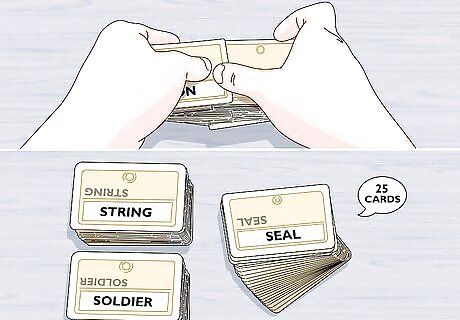
Shuffle the deck and choose randomly. The official Codenames game comes with over 400 potential codename cards. Shuffle up the deck nicely and pull out 25 of them randomly. You won’t need to use any of the remaining cards for that round, so go ahead and put them away. If you’re using the Codenames app or playing online, they’ll automatically choose 25 codename cards for you.
Set up a 5 by 5 grid with the cards.
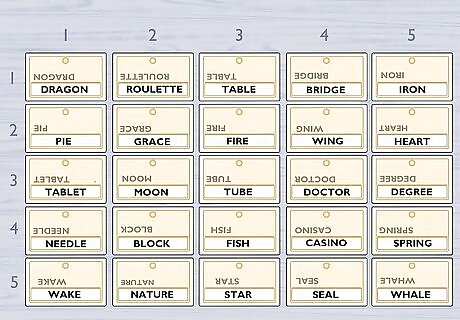
Make an even square with the code words facing up. Take the 25 cards and arrange them into 5 rows adjacent rows of 5 cards. Form a perfect square so the playing area is nice and neat. The Codenames app or online game will also automatically form a 25-card grid.
Choose 1 keycard from the deck.
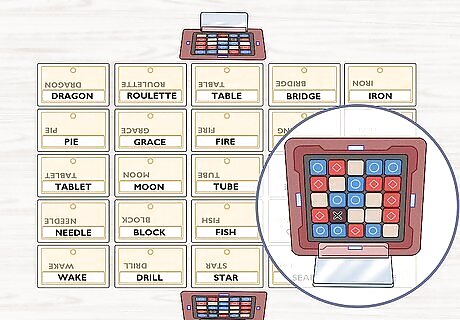
Place it on the stand in front of the spymasters. The keycard tells the spymasters the identities behind the codename cards in the playing area. Have the spymasters choose 1 keycard and keep it out of view from the other players. Use the keycard stand that comes with the Codenames game or just keep the card hidden from the other players. Both spymasters need to be able to see the keycard.
Deal out 8 agent cards to each team.
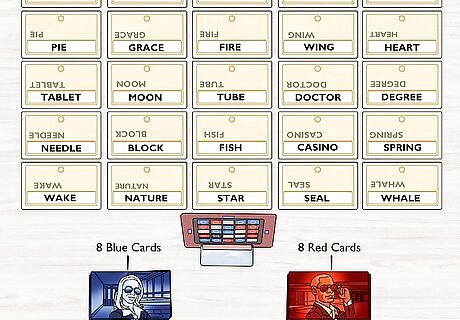
Choose 8 red and 8 blue cards. Both teams have a color assigned to them: one team is red and the other is blue. Each team has 8 agent cards that match their team color. Count out the cards and place them in front of the team’s spymaster.
Flip 1 double agent card to the starting team.

The color on the keycard indicates the starting team. Look for the colored rectangles on the outer edge of the keycard. If they’re blue, then the blue team goes first. If they’re red, then the red team goes first. Take 1 of the agent cards away from the opposing team, flip it over to the other team’s color, and add it to the starting team’s pile. The double agent card balances out the advantage that the team who goes first has. The starting team will have 9 agents and the other team will have 8. If you’re playing online or in an app, the game will automatically flip a double agent card over to the starting team.
Gather the agent cards, 7 bystanders, and 1 assassin card.
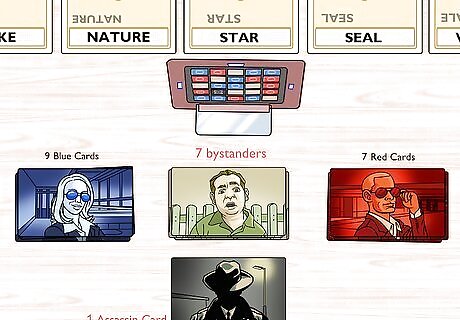
Place them all in front of the spymasters. Place the stacks of agent cards in front of their respective spymaster. Then, stack 7 bystander cards in the center and place the single assassin card near them. The online game or app will keep track of the cards for you.
Give a 1-word clue and a number.

Use only 1 word and a number to give your teammates a hint. The word gives a clue about which codenames correspond to a friendly agent and the number tells your team how many possible codename cards match the clue. The spymaster on the starting team goes first. Say only the 1-word clue and the number, and that is it. No other hints, facial expressions, or any other potential clues can be given. For example, the spymaster could say, “Nature, 2.” Their teammates can then select the codenames they think match the clue to try to identify their agents, such as a codename card that says “Tree” and another that says, “Bear.” Don’t use any phrases like, “Okay so this is kind of related” or “Alright, this is kind of like” before you give your 1-word clue. Be careful which word you use! Sometimes a clue could potentially cause your own teammates to choose an enemy agent. EXPERT TIP Ashton Wu Ashton Wu Board Game Expert Ashton Wu is a Board Game expert at Shelfside. After delving into the Yugioh tournament community while growing up, Ashton launched himself into the board gaming community in 2014 and went into reviewing board games as a career full-time in 2019. His YouTube channel Shelfside has over 35K subscribers and over 4 million views, assisted by written reviews on the Shelfside website and BoardGameGeek.com. He also consults with gaming companies to build high-quality gaming products. Ashton is a tournament commentator, board game playthrough director, and host of the Shelfside Podcast, where he talks about board games with his business partner, Daniel. He received a Bachelor of Arts in Economics at the University of California, Santa Barbara, in addition to the Technology Management Certificate. Ashton Wu Ashton Wu Board Game Expert Make your clues simple and high-impact. Prioritize hints that connect 3-4 words. Targeting 1-2 is a gamble, and aiming for five or more will create a minefield between your opponents' words and the black assassin card. Three to four is the golden zone. It lets you efficiently guide your team without unnecessary risks.
Guess up to the given number plus 1.
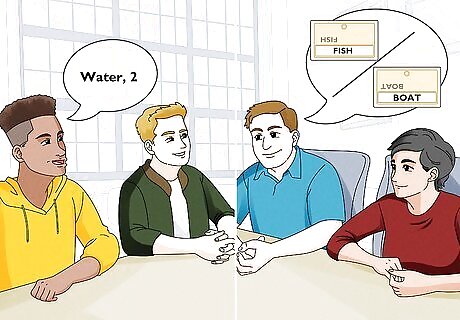
A team can pass or continue guessing if they choose correctly. You can only guess one codename at a time. If you successfully guess the codename and identify an agent, you can then choose another codename. You’re allowed to guess as many times as the number that your spymaster gave you plus 1. If you guess incorrectly, you lose your turn. For instance, if the spymaster says, “Water, 2” you could choose a codename card like “Boat” and “Fish.” If they’re both right, you have the chance to make 1 more guess. You could make a blind guess or try to use an older clue to choose another codename card. If you guess the opposing team’s codename, then they get to place an agent card on the codename. If you guess a bystander, then your turn is over and a bystander card is placed over the codename. If you guess the assassin card, then your team loses the game. Your team must make at least 1 guess, but you’re allowed to pass after your first guess if you like.
Place an agent or bystander card over the chosen codename card.
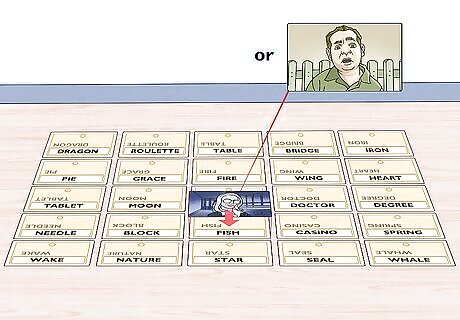
Reveal the identity behind the codename card your team has chosen. After a team uses the spymaster’s clue to make a guess, the spymaster reveals the identity behind the codename. If it’s one of their agents, then they’ve guessed correctly and one of their agent cards is placed on top. If it’s an opposing team’s agent or a bystander, then one of those cards are placed on top of the codename card. If they’ve chosen the assassin, then the assassin card is placed on to of the codename card and the game is over.
Take turns giving codewords until there is a winner.
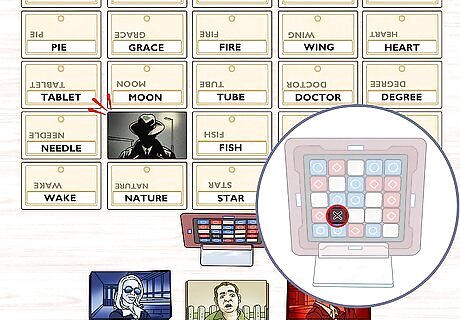
The game ends when 1 team identifies their agents or the assassin. Each team’s takes turns making their guesses using the clue provided by their spymaster. The game ends whenever 1 team has identified all of their agents, or the assassin card is chosen. The team that chooses the assassin automatically loses.



















Comments
0 comment